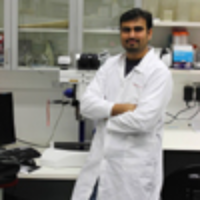Arid3a regulates mesoderm differentiation in mouse embryonic stem cells
Published on: 7th September, 2017
OCLC Number/Unique Identifier: 8291643721
Research into regulation of the differentiation of stem cells is critical to understanding early developmental decisions and later development growth. The transcription factor ARID3A previously was shown to be critical for trophectoderm and hematopoetic development. Expression of ARID3A increases during embryonic differentiation, but the underlying reason remained unclear. Here we show that Arid3a null embryonic stem (ES) cells maintain an undifferentiated gene expression pattern and form teratomas in immune-compromised mice. However, Arid3a null ES cells differentiated in vitro into embryoid bodies (EBs) significantly faster than control ES cells, and the majority forming large cystic embryoid EBs. Analysis of gene expression during this transition indicated that Arid3a nulls differentiated spontaneously into mesoderm and neuroectoderm lineages. While young ARID3A-deficient mice showed no gross tissue morphology, proliferative and structural abnormalities were observed in the kidneys of older null mice. Together these data suggest that ARID3A is not only required hematopoiesis, but is critical for early mesoderm differentiation.
The beneficial effects of varicella zoster virus
Published on: 15th July, 2019
OCLC Number/Unique Identifier: 8186245399
Varicella zoster virus behaves differently from other herpes viruses as it differs from them in many aspects. Recently, there has been growing evidence on the beneficial effects of the virus in immune compromised hosts and these effects are translated into prolongation of survival. The reported beneficial effects of the virus include: (1) stimulation of bone marrow activity in patients with hematologic malignancies and bone marrow failure syndromes, (2) antitumor effects in various hematologic malignancies and solid tumors, and (3) association with graft versus host disease which has anticancer effects. Additionally, there are several reports on the safety of the live-attenuated even in severely immune suppressed individuals and on the emerging role of the virus in cancer immunotherapy. In this review, the following aspects of the virus will be thoroughly discussed: (1) new data on the genetic background, pathogenesis, vaccination, and new therapeutic modalities; (2) bone marrow microenvironment and hematopoiesis; (3) cells involved in the pathogenesis of the virus such as: mesenchymal stem cells, dendritic cells, natural killer cells, T-cells and mononuclear cells; (4) cellular proteins such as open reading frames, glycoproteins, promyelocytic leukemia protein, chaperons, and SUMOs; (5) extracellular vesicles, exosomes, and micro-RNAs; and (6) signaling pathways, cytokines, and interferons.
Correlation of plasma protein from MDS, young and elderly patients by SDS-page
Published on: 11th November, 2019
OCLC Number/Unique Identifier: 8330254423
Summary: Myelodysplastic Syndrome (MDS) is a heterogeneous group of clonal hematopoietic malignancies characterized by progressive cytopenias, ineffective hematopoiesis, bone marrow hypercellularity and transformation to acute myeloid leukemia (AML).
Objectives: Identify plasma proteins from MDS patients and from two healthy controls groups (young and elderly) by SDS-Page.
Methods: Plasma from 08 healthy young, 08 healthy elderly and 08 MDS patients were used for this study. Proteins were fractionated, precipitated, used for SDS-PAGE gel analysis, stained with comassie brilliant blue, scanned and bands were analyzed.
Results: It was possible to identify in both, 20% fraction and supernatant, proteins that were differentially expressed in each group. The ones that have showed some clinical relevance. Fibronectin was highly expressed only in the young control group. α2-Macroglobulin was also expressed in both control groups, but it was not expressed in the MDS group. Haptoglobin was highly expressed only in the elderly control and SMD groups.
Conclusion: Protein expression in plasma can be a biomarker for MDS, and may play a key role in the process of aging and hematologic malignancies development.
Interconnection and Communication between Bone Marrow - The Central Immune System - And the Central Nervous System
Published on: 25th September, 2023
Bone marrow and the central nervous system are both protected by bone. The two systems are interconnected not only structurally but also functionally. In both systems specialized cells communicate through synapses. There exists a tridirectional communication within the neuroimmune network, including the hormonal system, the immune system, and the nervous system. Bone marrow is a priming site for T cell responses to blood-borne antigens including those from the central nervous system. In cases of auto (self) antigens, the responses lead to immune tolerance while in cases of neo (non-self) antigens, the responses lead to neoantigen-specific T cell activation, immune control, and finally to the generation of neoantigen-specific immunological memory. Bone marrow has an important function in the storage and maintenance of immunological memory. It is a multifunctional and very active cell-generating organ, constantly providing hematopoiesis and osteogenesis in finely-tuned homeostasis. Clinical perspectives include mesenchymal stem cell transplantation for tissue repair within the central nervous system.
Exploring the Potential of Medicinal Plants in Bone Marrow Regeneration and Hematopoietic Stem Cell Therapy
Published on: 31st January, 2025
Blood cell production through hematopoiesis within the bone marrow serves both to maintain blood equilibrium and to respond to tissue injury and infectious demands. Hematopoietic stem cell (HSC) therapy developments have revolutionized medical treatment approaches for anemia leukemia and bone marrow failure caused by chemotherapy or radiation exposure. The therapeutic compounds present in medicinal plants have traditionally supported blood health and researchers now understand these plants could help regenerate bone marrow tissue. The analysis investigates how phytochemicals affect HSC proliferation and differentiation while supporting HSC survival. The medicinal plants Panax ginseng, Astragalus membranaceus, and Curcuma longa receive special attention for their documented ability to enhance hematopoiesis in preclinical and clinical settings. This review examines the challenges that include standardization issues, toxicity concerns, and regulatory barriers alongside future perspectives about combining plant-based therapies with traditional treatments to improve bone marrow recovery and health results.




